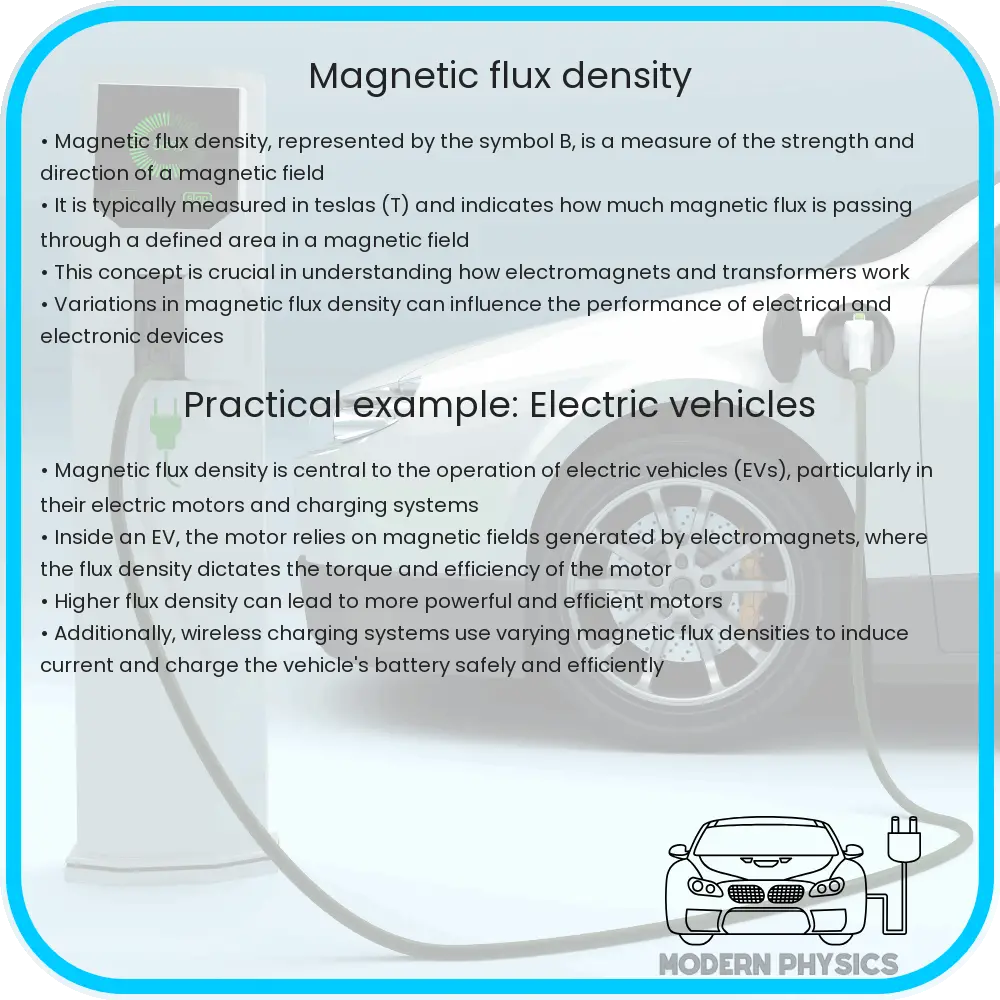Explore magnetic flux density: its measurement, units, applications in MRI, electrical engineering, and impact on technology and safety.

Magnetic Flux Density: Understanding the Fundamental Concept
Magnetic flux density, a cornerstone concept in electromagnetism, plays a critical role in various scientific and engineering applications. It refers to the amount of magnetic field passing perpendicularly through a given area. This concept is pivotal in understanding the behavior of magnetic fields in different contexts, from simple educational experiments to complex industrial applications.
Measurement of Magnetic Flux Density
The measurement of magnetic flux density is essential in quantifying the strength and direction of a magnetic field. It is typically measured using a device known as a Gaussmeter or Teslameter. These instruments detect the magnetic field’s intensity and provide readings in Tesla (T) or Gauss (G), where 1 Tesla equals 10,000 Gauss. The measurement process often involves placing the sensor in the desired location and orientation to accurately capture the magnetic field’s characteristics.
Units of Magnetic Flux Density
The SI unit of magnetic flux density is the Tesla (T), named after Nikola Tesla, a renowned inventor and electrical engineer. The Tesla is a large unit, so in practice, smaller units like the Gauss (G) are frequently used, especially in fields like geology and medicine. One Gauss is one ten-thousandth of a Tesla (1 G = 10-4 T).
Applications of Magnetic Flux Density
- Medical Imaging: Magnetic flux density is crucial in Magnetic Resonance Imaging (MRI). MRI scanners use strong magnetic fields to produce detailed images of the body’s interior, aiding in medical diagnosis.
- Electrical Engineering: In electrical engineering, magnetic flux density is vital for designing and analyzing motors, generators, and transformers. It helps in understanding the magnetic effects on electrical conductors and the optimization of these devices.
- Research and Development: Scientists use magnetic flux density in research, especially in physics and material science, to study magnetic properties and behaviors of materials under different magnetic field strengths.
Understanding the fundamentals of magnetic flux density is essential for professionals and students in physics, engineering, and related fields. Its measurement, units, and applications form the basis for numerous technological advancements and scientific explorations.
Further Insights into Magnetic Flux Density
Delving deeper into the concept, magnetic flux density can also be understood in terms of its relationship with other electromagnetic phenomena. For instance, the Lorentz force law, which describes the force on a charged particle moving in a magnetic field, is directly dependent on the magnetic flux density. This relationship is pivotal in the design of particle accelerators and understanding astrophysical phenomena.
Technological Innovations Influenced by Magnetic Flux Density
Technological advancements have been significantly influenced by the applications of magnetic flux density. One notable example is in the field of renewable energy, particularly in wind turbines. The efficiency of these turbines is largely dependent on the design of their magnetic generators, where magnetic flux density plays a critical role. Additionally, in the realm of transportation, magnetic levitation (maglev) trains exemplify the practical application of magnetic flux density, offering high-speed, efficient travel by reducing friction through magnetic levitation.
Environmental and Safety Considerations
With the increasing use of magnetic fields in various technologies, environmental and safety considerations have become paramount. Regulations and guidelines regarding exposure to magnetic fields are critical, especially in workplaces and medical settings. Understanding magnetic flux density helps in creating safer environments, particularly in industries where high-intensity magnetic fields are prevalent.
Conclusion
Magnetic flux density is a fundamental concept in electromagnetism that has far-reaching implications across various scientific and technological domains. From its critical role in medical imaging and electrical engineering to its impact on cutting-edge technologies like maglev trains and renewable energy sources, the understanding and application of magnetic flux density continue to drive innovation and scientific discovery. As technology evolves, the importance of comprehending, measuring, and safely applying magnetic flux density will only grow, underlining its significance in both current and future scientific advancements.
For professionals and enthusiasts alike, an appreciation of magnetic flux density offers a deeper understanding of the invisible forces that shape our modern world, highlighting the intricate interplay between science and technology in our daily lives.
